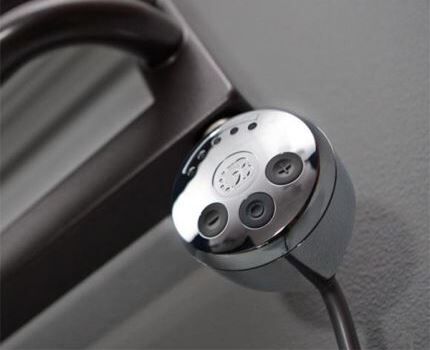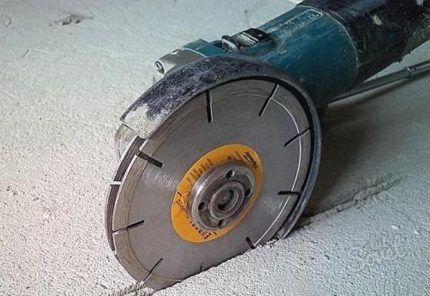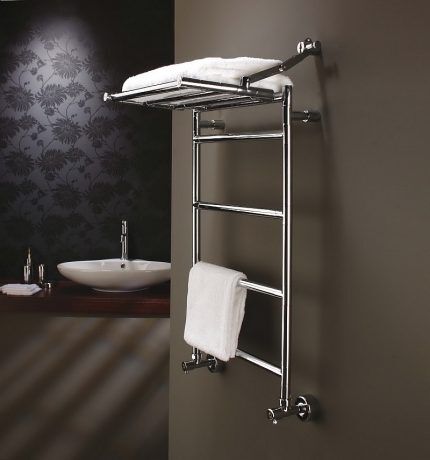Connecting an electric heated towel rail: step-by-step installation instructions
Ease of installation and aesthetics have shifted consumer choice towards easy-to-use electric heated towel rail. But its independent installation does not come down to simply fixing the equipment with 4-8 screws.
Therefore, let’s figure out how to properly connect the electrical heated towel rail (EPS) in the bathroom.
The content of the article:
What is the value of modern heated towel rails?
Heated towel rails have become a great boon for residents of high-rise buildings for many reasons.
The electrical basis of this equipment allows you to avoid the complexity of installation and repair. Mermen heated towel rails They require a separate riser in the bathroom niche, which in old houses has long since rusted and practically rotted in the cemented interfloor ceilings.
Residents save time on contacting Housing office to stop the supply of coolant when repairing a leaking water devices.
Aesthetics and hygiene EPS obvious. There are hundreds of models of this equipment that will allow you to choose the required size, desired appearance and convenient functionality - read more about the features of choice Further.
There is no need to paint pipes, clean seams and be afraid of ruining the fabric. In addition, impractical piping, which often stretches across two walls, is excluded from the installation diagram.
The ability to use adjusting devices has increased the functionality of electricaldevices to heaven. Can choose EPS with timer, with temperature control, with backlight, with shelves. Although to save money you can simply heated towel rail plug into an outlet with a built-in timer.
Fastening heated towel rails on rotary axes to rotate the frame in the desired direction is also a useful development of an engineering idea.
Electrical equipment allows for controlled heating of bathrooms. In apartment buildings with individual heating, the bathroom is often a dead-end branch in the heating distribution: pipes run into the bathroom through the kitchen, which is loaded with communications.
Application of autonomous heated towel rail helps to remove unnecessary heating pipes in the bathroom, simplifies the situation in the kitchen and improves ergonomics, improves the appearance of the room and significantly simplifies cleaning.

Electrical heated towel rails They perform their main job with dignity - drying towels and clothes. Chrome-plated tubes will never harm and will not leave marks even on delicate fabric.
You can list further the advantages of electric heated towel rail, but it’s better to install it in your bathroom and feel all the benefits yourself. Psychological effect of editing EPS comparable to installing a modern washing machine after years of hand washing!

Operation without installation is a reality
If you do not take into account additional options, then heated towel rails in appearance they are simply metal tubes welded into a frame with an electrical cable coming out of them, so people often choose EPS, focusing only on its design appearance.
Manufacturing companies take this marketing nuance into account and try to offer consumers original engineering ideas.
The result of the implementation of one of these ideas was the floor heated towel rail. It does not require installation at all; to turn it on, you just need to plug the device into a power outlet. This option is suitable for bathrooms with a large area and a permanent dry floor area where the device can fit without interference.

Mounted electric heated towel rails They also have installation features. Some models are equipped with an electrical cable that is built into one of the wall mounts. Such heated towel rails It is advisable to install it before laying tiles in the bathroom.
Installing the device in the bathroom
There are three electrical installation options heated towel rails:
- Installation of floor EPS.
- Installation of equipment before laying wall tiles.
- Connection heated towel rail on the laid tile.
Before instrumental installation work, you must first decide on the installation location EPS in accordance with simple rules.
Device placement rules
IN Khrushchev buildings the place for heated towel rail there is no choice due to geometric space limitations. But in private houses and modern apartments with large bathrooms, it is advisable to take into account the following rules during installation EPS. The main criterion when choosing a location is its moisture protection.

The described rules are not the whim of some author, but were created for the safety of people during the operation of heating electrical equipment.
Connection EPS to the network
If the bathroom already has all the interior decoration, and you are not going to change anything, then in this case heated towel rails It is advisable to place it closer to the power source.

Replacement electrical cables to a longer version or its extension by creating splints will lead to loss of warranty service for the device.
Therefore, electrical connection options heated towel rail If the outlet is far away, you can offer a little:
- Buy floor heated towel rail, which can be placed closer to the outlet if necessary.
- Install additional waterproof socket close EPSby pulling the cable in a box from an existing power supply point. This option is the least aesthetic and unsafe option.
- If you have removable ceiling panels, you can extend the cable from the ceiling light by installing an additional socket under the ceiling above heated towel rail.
- Lengthen electrical cable, voiding the free warranty service.
- Grooving carefully wall away from the existing electrified point and install an additional waterproof socket recessed into the wall.
Although electricity consumption EPS rarely exceeds half a kilowatt, the socket for connecting it must have sufficient power reserve and be waterproof. If you handle the shower head carelessly, water may enter the electrical contacts and cause a short circuit and fire.
Therefore, use only waterproof, certified electrical equipment in the bathroom.

The introduction of the latest technologies in the field of materials physics makes the application devices absolutely safe even under voltage of 220 V. New dielectric materials and innovative engineering insulation techniques guarantee the absence of inducing currents in the housing while maintaining its high thermal conductivity.
But you should not neglect the installation of protective equipment, because its work is designed specifically for cases of breakdown of electrical appliances and violation of their insulation.
Laying electrical wiring in the bathroom
If installation heated towel rail coincides with or precedes the laying of tiles in the bathroom, then you should pay attention to the rules for laying cables and installation electrical outlets in damp areas.
Let's consider installation recommendations for installing electrical wiring in the bathroom:
- the power supply line must be grounded;
- all elements of the installed wiring must be waterproof;
- Separate automation must be installed on sockets and lamps (RCD), which will turn off the power supply in case of current leakage;
- It is advisable to choose copper wires with non-flammable winding;
- Be sure to use a three-core cable to ground all electrical appliances.
To lay the cable to the planned outlet, you first need to make a groove (groove) for the wire with a grinder.

Then, using a drill with a special attachment, a recess is made in the wall for the socket.

Then the cable is laid in the groove, which is pressed with special clamps or simply fixed every 15-20 cm with cement mortar. After that put socket box and the waterproof socket itself is mounted. More detailed instructions on installing sockets in the bathroom can be found in this material.
When installing electrical heated towel rail With a hidden entrance, no socket installation is required.It is enough to leave a “tail” of the electrical wire measuring 10-15 cm in the right place.
If you have already purchased an electric heated towel rail and you have an outlet in a convenient place, then it’s time to move on to the stage of attaching the equipment to the wall.
How to drill holes in tiles?
Having completed all measurements and marked with a marker the points for screwing in the fixing EPS screws, you need to drill holes for installation dowels.
Let's reveal some secrets of correct and safe drilling of tiles:
- It is not recommended to drill holes near the edges of the tiles and in the spaces between the tiles;
- to prevent overheating of the drill, you can periodically dip it in a glass of clean water;
- if drilling is carried out with a hammer drill, then first the tiles are drilled in a non-stress mode, and then additional drilling in hammer drill mode;
Note that when drilling tiles at low speeds, it is permissible to use a metal drill.
The procedure for drilling a hole in a tile is as follows:
- Use a marker to mark points on the tile.
- Carefully beat the enamel at the intended point using a drill at low speeds or the tip of a file.
- If you can’t beat the enamel, you can stick a piece of tape over the drilling site to prevent the drill from slipping.
- Drill the tile in non-impact mode.
- Drill the wall using a hammer drill with maximum pressure.
After all the holes have been formed, plastic dowels.

For each type of wall, appropriate fasteners are used for more reliable fixation heated towel rails.

It is possible to use all the options shown in the figure.
Direct installation heated towel rail on the wall
Install electrical heated towel rail It’s better to hang on the wall with an assistant. You can do this yourself, but it is better to have one person hold the device, and the second screw it to the wall with screws.
Between the vertical wall and the legs EPS do not forget to place the rubber or plastic seals that come with the heated towel rail.

Hang heated towel rail necessary only after disconnecting it from the electrical network. After installation EPS On the wall, you can proceed to the most important stage - connecting the equipment to the network.
Commissioning rules
Before you plug in the cord heated towel rail plug into the outlet, be sure to read the operating instructions that come with the equipment.
Even if EPS There are no adjustment components, you still need to familiarize yourself with the following equipment characteristics:
- maximum power consumption;
- minimum and maximum heating temperature;
- maximum time spent in the on state;
- restrictions on the types of fabrics that can be dried.
We should not forget about the danger of burns for children when they come into contact with electrical parts. heated towel rail. It is advisable to talk about the new device with small family members, but it is better to stage the usual actions of children in the bathroom when it is turned off. EPS.
This will help you see potential hazards and prevent injury.

You cannot start using electrical heated towel rails:
- until installation on the wall is completed;
- disassembled;
- in rooms with damaged wiring;
- when connected to an ungrounded outlet.
Before using for the first time, wipe the case heated towel rail with a damp cloth, remove construction dust and greasy stains, wait until the surface dries. If the instructions have been read and all safety requirements have been met, then you can safely turn on the electric heated towel rail to the network.
Use of electric heated towel rail
EPS can be installed not only in the bathroom or combined toilet. Installation of this equipment is possible anywhere in an apartment or house. Floor-mounted portable ones are especially convenient in this regard. heated towel rails. To dry things faster, the device can also be connected to an electrical outlet on the balcony or outside.

Recommendations for using electric heated towel rail:
- try to use only crossbars for drying things;
- do not place on the body EPS products made of paper or plastic;
- don't clean heated towel rail in the on state;
- Do not lean on the crossbars.
Compliance with these rules will extend the life of the electrical heated towel rail and will protect it from damage.But if the equipment does break down, do not rush to call a specialist - you can handle the breakdown yourself. You can read how to do this Here.
A quick photo guide for home installers
A selection of photos will illustrate the stages of installation and connection of an electric dryer:
The connection is complete, now all that remains is to mount the electric dryer on the wall, to do this:
There is nothing particularly complicated about installing and connecting an electric dryer. You can handle the installation yourself without calling an electrician. However, you will still need an assistant to hold the device.
Important installation and design information EPS
Electrical installation heated towel rail does not require specialized tools: grinder, welding machine, soldering iron. To install it, all you need is a screwdriver and a drill, which, in extreme cases, you can ask your neighbor for.
Therefore, fastening EPS The repaired wall can be carried out by anyone with basic skills in working with a drill.
Electrical heated towel rails do not require special communications if there is a nearby installation installed according to the rules electrical outlet. Wall structures in some models allow the frame to be rotated EPS to save space in the bathroom.
Maximum operating surface temperature for most heated towel rails limited to 70 °C, which is enough to heat a small room in the cold season.

Models EPS, having oil as a coolant, are demanding on the level of inclination of the transverse bars. Therefore this type EPS It is recommended to install horizontally and strictly adhere to the lower position heating element, according to instructions.
Conclusions and useful video on the topic
Hidden connection EPS:
Installation on a plasterboard wall lined with tiles:
Step-by-step instructions in pictures:
Compliance with the installation instructions described above will help any householder install electrical heated towel rail on one's own. These tips will help you avoid cracks in your ceramic tiles, keep your drill bits working, and protect your family from accidents and injuries.
Perhaps you have already encountered the installation of a heated towel rail and can you give valuable advice to our readers? Please share your experience and ask questions in the block below. You can supplement your comments with photographs.




In our old apartment we had a water heated towel rail, but when we moved to the new one, there was none in the bathroom. I had to buy an electric one, because without it it is inconvenient and cool.It turned out that there are heated towel rails with a cable inside, and there are ones filled with oil. I liked the oil-filled one, but it needs to be installed strictly according to the instructions. What are the advantages of such an electrical appliance: it doesn’t require anything other than electricity and connecting it turned out to be as easy as shelling pears, you don’t need to cut into any additional communications, but it’s really more convenient to do it together, it will work out smoother. Well, of course, I would recommend unplugging it from the outlet while you are away.
Interesting, this is the first time I’ve heard about electric heated towel rails. I think that for me it would be much more convenient than the current water heated towel rails, which are cold half of the winter due to some problems of the housing office, and even in the summer it happens that the hot water from which they operate is turned off. And for some, they are also connected to heating, and not to hot water, then they don’t work at all all summer. The only thing is that you will have to pay extra for electricity, but I think it’s worth it.
Tell me, does an electric heated towel rail have to be equipped with a switch? Our developer installed a model in the control system that for some reason does not have a switch... I suspect that this should not be the case. How and how is this regulated according to electrical and fire safety rules?
Hello. In fact, all modern models of electric heated towel rails are equipped with switches. True, sometimes the switch on the substation is placed in such a way that it is quite difficult to notice.
If you do have a PS model installed that does not have a switch, then this is easy to fix yourself; there are several options for solving this issue:
— differential switch, also known as RCD;
— insertion of a small switch with backlight (attached photo);
— connect the heated towel rail via a Wi-Fi socket.
The last option is quite practical, since you can control the PS from anywhere.
In the photo you have a connection without grounding, only two power ones. Has anyone been scared yet? I have the same story, the house is old, the electrics are old, but copper, without grounding. For the washing machine, I installed a separate grounding from the machine to the riser, but now I have my doubts about the machine. And everything has already been laid with tiles...